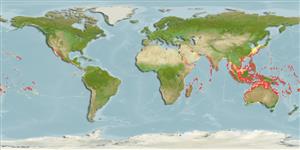Common names from other countries
Classification / Names / Names
Namen | Synonyme | Catalog of Fishes (gen., sp.) | ITIS | CoL | WoRMS
Environment: milieu / climate zone / depth range / distribution range
Ökologie
; tiefenbereich 0 - 100 m (Ref. 348), usually 0 - 5 m (Ref. 348). Tropical
Indo-Pacific: from East Africa, to eastern Polynesia; north to Japan and south to Queensland and New Caledonia.
Length at first maturity / Size / Gewicht / Alter
Maturity: Lm ? range ? - ? cm Max length : 11.0 cm SHL Männchen/unbestimmt; (Ref. 348); common length : 8.5 cm Männchen/unbestimmt; (Ref. 348)
Maximum depth from Ref. 101147. Attached by its byssus to coral slabs, rubble under the slab (Ref. 101147), under coral heads and rocks (Ref. 348). Frequently encrusted by sponges, bryozoans, algae, and other marine growths. Able to swim actively for some distance when detached. Common in the intertidal and shallow subtidal zones (Ref. 348). Also occurs on rubble, soft sediments, and scattered reefs (Ref. 87907). At night, adults seem to move to open water to feed and return to rubble pile in the day (Ref. 101147).
Life cycle and mating behavior
Geschlechtsreife | Fortpflanzung | Ablaichen | Eier | Fecundity | Larven
Members of the class Bivalvia are mostly gonochoric, some are protandric hermaphrodites. Life cycle: Embryos develop into free-swimming trocophore larvae, succeeded by the bivalve veliger, resembling a miniature clam.
Poutiers, J.M. 1998. (Ref. 348)
IUCN Rote Liste Status (Ref. 130435)
CITES Status (Ref. 108899)
Not Evaluated
Not Evaluated
Bedrohung für Menschen
Harmless
Nutzung durch Menschen
| FishSource |
Tools
Mehr Information
Alter/Größe
Wachstum
Länge-Gewicht
Länge-Länge
Morphologie
Larven
Dichte
Internet Quellen
Estimates based on models
Preferred temperature
(Ref.
115969): 24.6 - 29.2, mean 28.3 (based on 3624 cells).
Verwundbarkeit
Low vulnerability (10 of 100).
